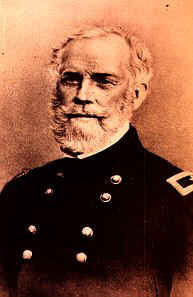Declaring "By God, I'm for battle -
no peace," General Harney (below) leads his troops west and
soon surrounds the Brule leader, Little Thunder, at Blue Water
Creek, north of Ash Hollow near the North Platte River.
Harney's aggression gave the Sioux little choice but to respond
with violent resistance.
On Sept. 3, the
Sioux learned the power of the US military when Harney destroyed
Little Thunder's camp, rounded up 70 hostages of women and
children, and then moved on to challenge other groups who had been
called in by the new agent for the Upper Platte, Thomas S. Twiss,
for a peace council. That peace, Harney declared, would only
come after they had given up "the murderers" who attached a mail
wagon near Fort Laramie.

These and other encounters with
Harney, seemingly unprovoked, taught the western tribes that
despite the peaceful coexistence promised in the 1851 treaty at
Horse Creek, the White Man's Medicine Trail (the Oregon Trail) was
to be regarded as belonging exclusively to the white nation.
At a council with the Sioux in March 1856, Harney, who regarded
Horse Creek as amounting to nothing more than "molasses and
crackers,' issued his own ultimatum: "The Indians must not obstruct
or lurk in the vicinity of roads traveled by whites."
He conducted a council on
Nov. 9 at Fort Pierre, telling the Indians that warfare against the
Sioux would be halted only if all demands of the government were
accepted.
Enboldended by Harney's strong
showing, Congress continued to appropriate money for new roads that
would now be "built through the territories purely as aids to their
development and settlement," despite the fact that just three years
earlier, Congress had ratified a treaty that formally recognized
the Indians as the titled owners of that land.
Harney's
massacre of Little Thunder's band is among the first 'post Laramie
massacre's' that would mark the U.S.'s official policy toward the
'savages' of the plains. "Though hailed as a great victory and an
additional plume in Harney's crest of fame," wrote one historian,
"the battle of Ash Hollow was a shameful affair, unworthy of
American arms and a disgrace to the officer who planned and
executed it…the opportunity was not given (the Indians to
surrender) and the massacre which ensued was as needless and
barbarous as any which the Dakotas have at any time visited upon
the white people."
In July,
a treaty approved by Comanche, Apache and Kiowa, reaches
Washington. But things were not going well for their
neighbors to the north, the Arapaho and Cheyenne. The time
was not far distant when the buffalo would cease to exist, and with
the buffalo gone, relations with the tribes would take a dramatic
turn for the worse. (see profile in People)
Reflecting on his
many years of service in Indian Country at the end of his long
career, General Harney told Congress that he never knew an Indian
leader to break his word.
Related People
Related Events
Related Flashpoints